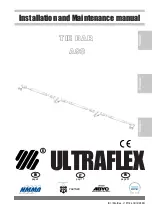
UltiMate 3000 Series:
NCS-3500RS and NCP-3200RS
Operating Instructions
Page
143
5.10.2 Maintenance Intervals
To ensure optimum performance and maximum uptime of the module, perform the
maintenance procedures listed in the table at regular intervals. The exact maintenance
schedule depends on a number of factors.
Frequency
What you should do...
Daily
Before you start operating the pump, inspect the fluid lines for air bubbles and degas
the solvent. Degas the solvent.
Check the fluid lines for indications of leakage.
Check the fluid connections for indications of salt deposits.
If the eluent is pure water, replace the eluent in the reservoir on a daily basis.
Check the liquid level in the seal wash reservoir.
Regularly check the liquid level in the waste containers for the drain liquid and seal
wash solution. Empty the containers as needed.
When using buffer solutions, flush the system thoroughly after use. Use a solvent
that does not contain buffers or salts.
Regularly
Inspect the tubing for indications of damage, such as cracks, nicks, cuts, or blockage.
Fill the seal wash reservoir, by using fresh liquid. Observe the precautions for the
composition of the seal wash solution on (
→
page 122).
When using buffer solutions, inspect the pump for leakage at least once a month
(
→
page 186).
Check the filter frits in the solvent supply line filters for permeability.
Replace the filter frits in regular intervals. This is especially important with aqueous
solvents. Aqueous solvents may contaminate the filters with algae and other
microorganisms that deposit on the filter frits. Therefore, use fresh the solvents at
regular intervals. Rinse the reservoirs thoroughly before filling them.
Drain tubing is connected to the drain ports on the bottom right of the module.
Verify that the tubes are unclogged and routed below the drain ports. Empty the
waste container as needed.
Inspect the electrodes of the seal wash detector for contamination. Clean the detector
electrodes if required (
→
page 181).
Classic flow meters:
Calibrate the pressure transducers if required (
→
page 172).
ProFlow flow meters:
Perform a zero balance of the flow sensors if required
(
→
page 172).
Check the permeability of the filter frit in the inline filter of the loading pump
(
→
page 208).
Clean the column chamber, by using a lint-free cloth. Use paper to absorb any
humidity in the column chamber.
The cleaner the column chamber is, the better the sensors are at detecting excessive
gas or humidity.
Inspect the seal installed in the front panel door. A defective door seal impairs the
performance of the column compartment.
If the seal is defective, contact Thermo Fisher Scientific Service for Dionex HPLC
Products.
Содержание Dionex UltiMate 3000 Series
Страница 2: ...UltiMate 3000 Series NCS 3500RS and NCP 3200RS Operating Instructions ...
Страница 8: ...UltiMate 3000 Series NCS 3500RS and NCP 3200RS Page vi Operating Instructions ...
Страница 24: ...UltiMate 3000 Series NCS 3500RS and NCP 3200RS Page 16 Operating Instructions ...
Страница 62: ...UltiMate 3000 Series NCS 3500RS and NCP 3200RS Page 54 Operating Instructions ...
Страница 92: ...UltiMate 3000 Series NCS 3500RS and NCP 3200RS Page 84 Operating Instructions ...
Страница 246: ...UltiMate 3000 Series NCS 3500RS and NCP 3200RS Page 238 Operating Instructions ...
Страница 262: ...UltiMate 3000 Series NCS 3500RS and NCP 3200RS Page 254 Operating Instructions ...
















































